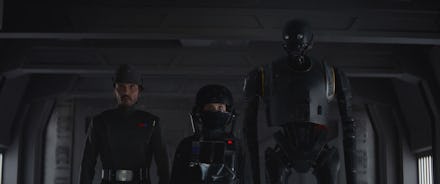'Rogue One' Ending: A spoiler-filled breakdown on the breathtaking final scenes

An overarching concern of blockbuster franchises is that they, quite simply, never want to end. You'll see a plethora of endless sequels and reboots, with results ranging from the good (like the understated, revamped Planet of the Apes) to the horrendously bad (the Ben-Hur reboot that actually happened).
That's one of the reasons Rogue One: A Star Wars story is so damn refreshing — it actually ends. There is no sequel in place, that already exists: It's called A New Hope. This also gave Rogue One the chance to do what few marquee franchises are afforded with their endings, but more on that below.
(Editor's note: Major, major spoilers for Rogue One ahead. Seriously, we're going to spoil the ending, so stop reading. We'll use a photo from Rogue One as a buffer, but after that, the onus is on you).
I'm not sure when it first dawned on me that, yes, Rogue One is going to kill off all of its primary protagonists. It probably hit after the comic relief of the film, the sardonic but lovable droid K-2SO, was gunned down by a bunch of Stormtroopers while helping Jyn Erso and Cassian Andor nab the plans for the Death Star.
It's not necessarily surprising — the titular Rogue One team was essentially consigned to a suicide mission after the Rebel Alliance couldn't unanimously agree whether or not to believe the claims that the Death Star has a weakness, hidden in the schematics of the battle station. But it's still breathtakingly sad to see on-screen, as the characters we've followed throughout the film are killed off, some quite unceremoniously.
The most heartbreaking is the final scene of Jyn and Cassian, who, after successfully sending the Death Star plans to the Rebels, are consigned to their fate after the Death Star (using less than its full capacity) strikes the surface of Scarif. They share a final embrace; a hug that will soon be enveloped by the Death Star's destructive force.
It's a more harrowing look at the "war" part of Star Wars, as Rogue One is the franchise's first exploration of the ground soldiers that comprise both the Rebels and the Empire, rather than the main players (Luke, Han Solo, Leia) who are pulling all the major strings. Another character pulling a lot of strings — but for the Empire — is Darth Vader, and no sooner are the Death Star plans in the clutches of the Rebels that he begins pursuing them.
It amounts to, arguably, the most terrifying sequence with the villain in the franchise. We've seen Vader and other lightsaber-wielding characters go toe-to-toe, and even when one is overmatched (like Luke in The Empire Strikes Back) it's an entertaining spar. However, a bunch of Rebels against Vader is an absolute slaughter. He picks them apart in whatever way he fancies in close quarters; be it a slash of his blade, using the Force to send one careening hard into the ceiling, or deflecting laser blasts right back towards them.
Thankfully (and well, duh), he doesn't get his hands on the plans to the Death Star, which make their way to Tantive IV, the ship that's featured in the opening sequence of A New Hope. Vader's Imperial Star Destroyer will soon be in hot pursuit, but aboard the ship, an exciting cameo takes place: Princess Leia shows up, in striking CGIed form. She says the Rebels now have "hope," which is Leia's premonition that the corresponding events will probably be called A New Hope or something.
It ties in quite nicely to A New Hope, in such a way that future Star Wars movie marathons will only be improved with the addition of Rogue One. The ending, and sheer amount of death, is atypical of the franchise, but for where it fits in the timeline it's the Star Wars movie that befits this type of conclusion.
Rogue One is currently playing in theaters.
Mic has ongoing coverage of both Star Wars and Rogue One. Please follow our main Rogue One and Star Wars hubs.